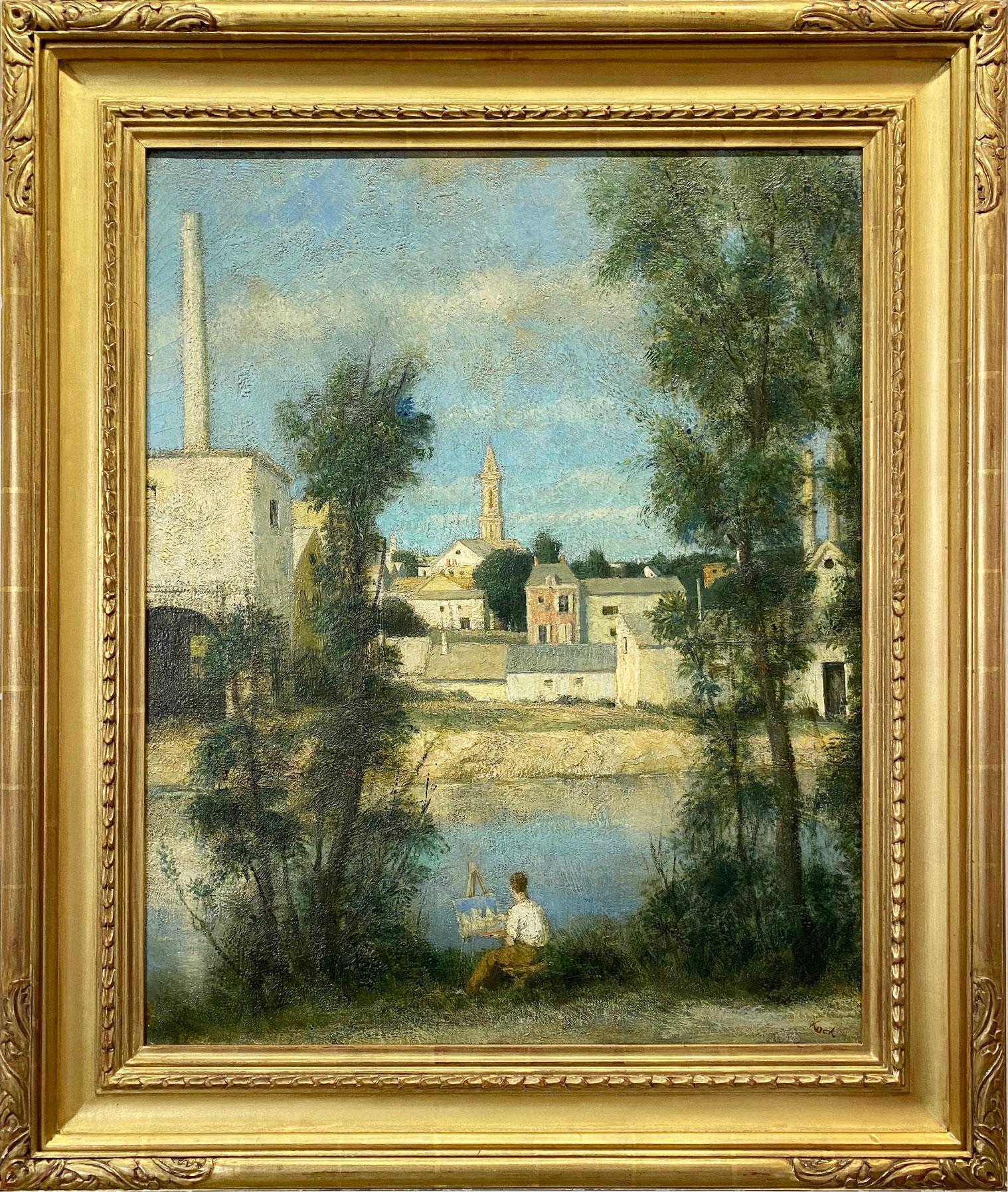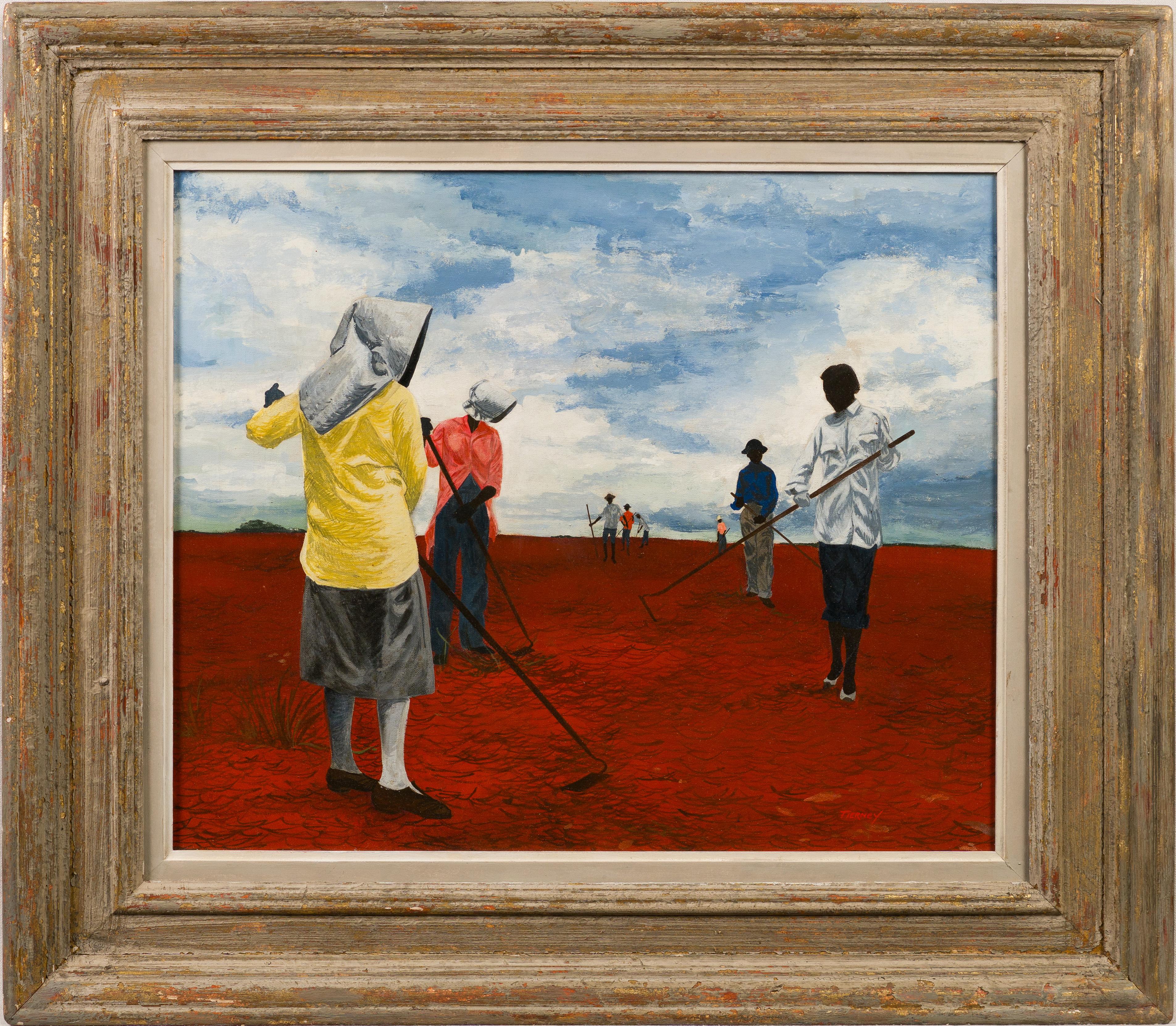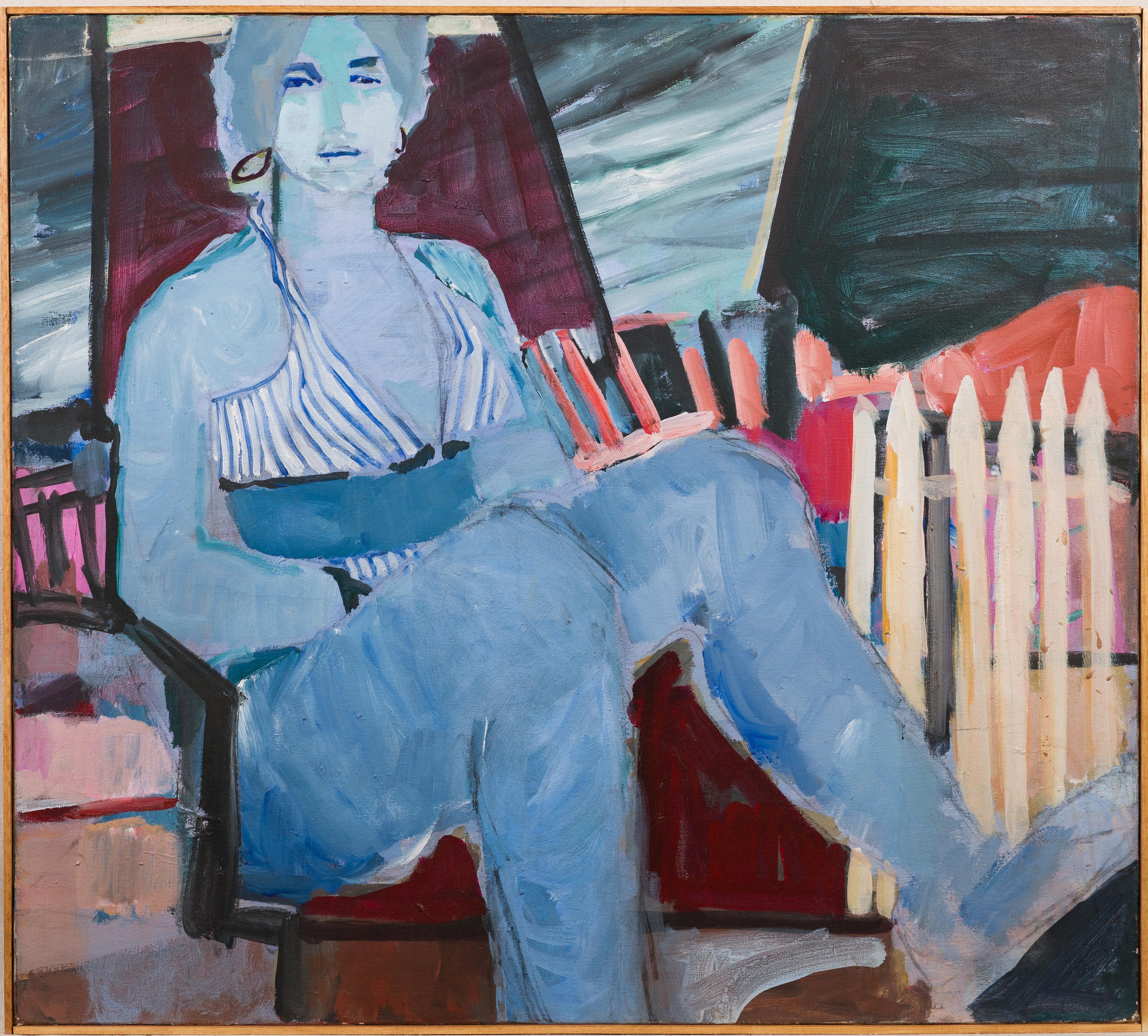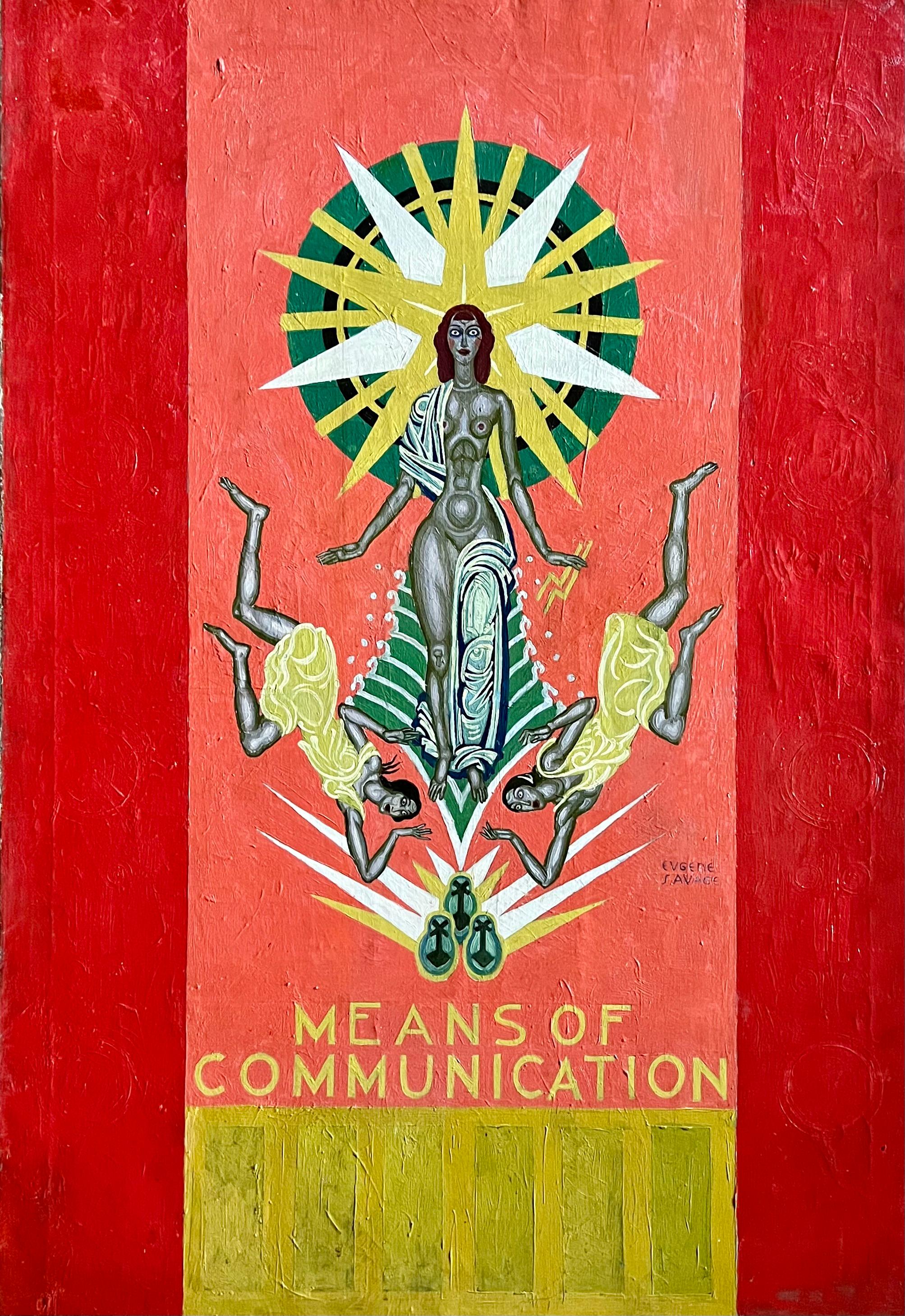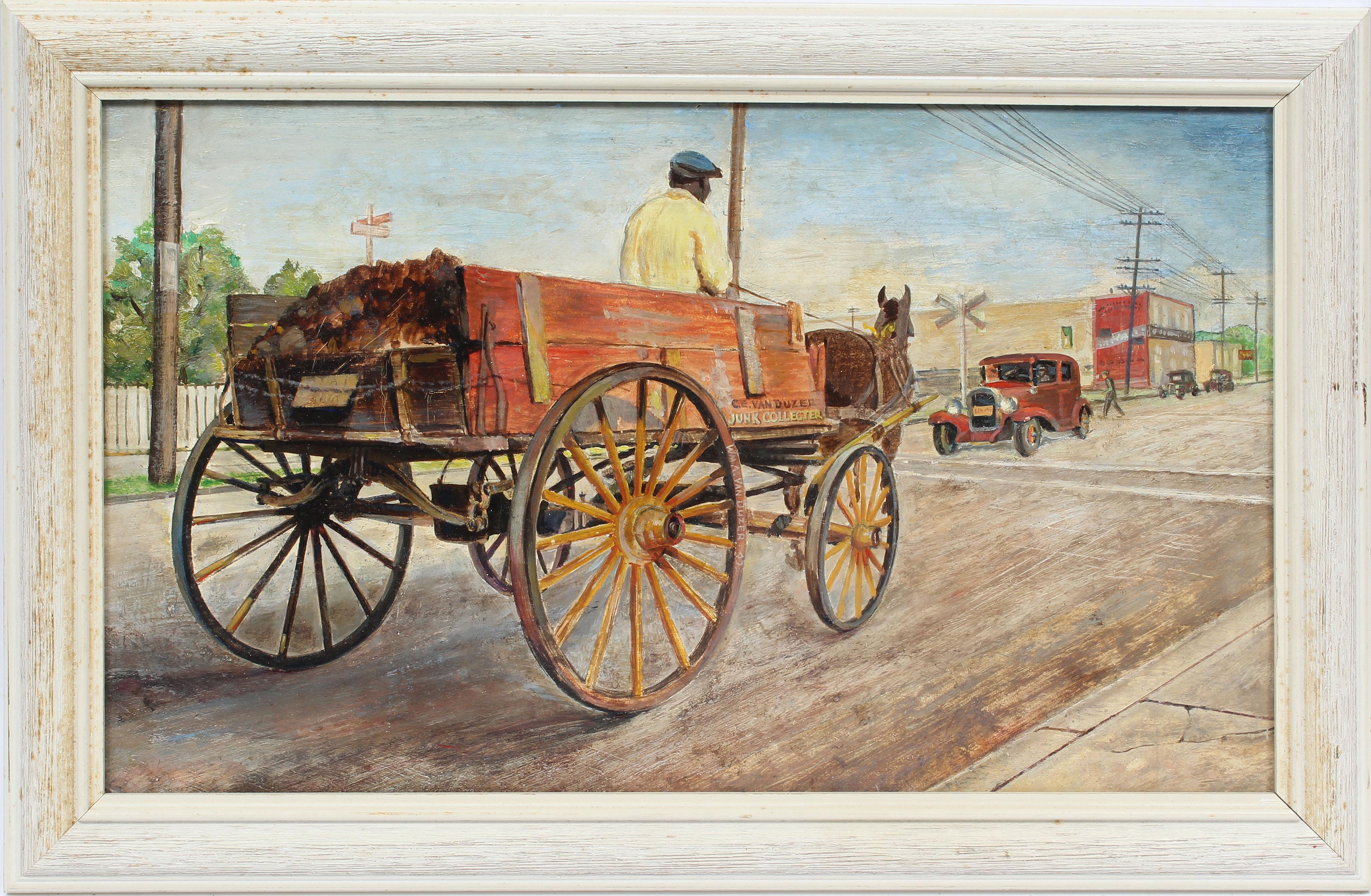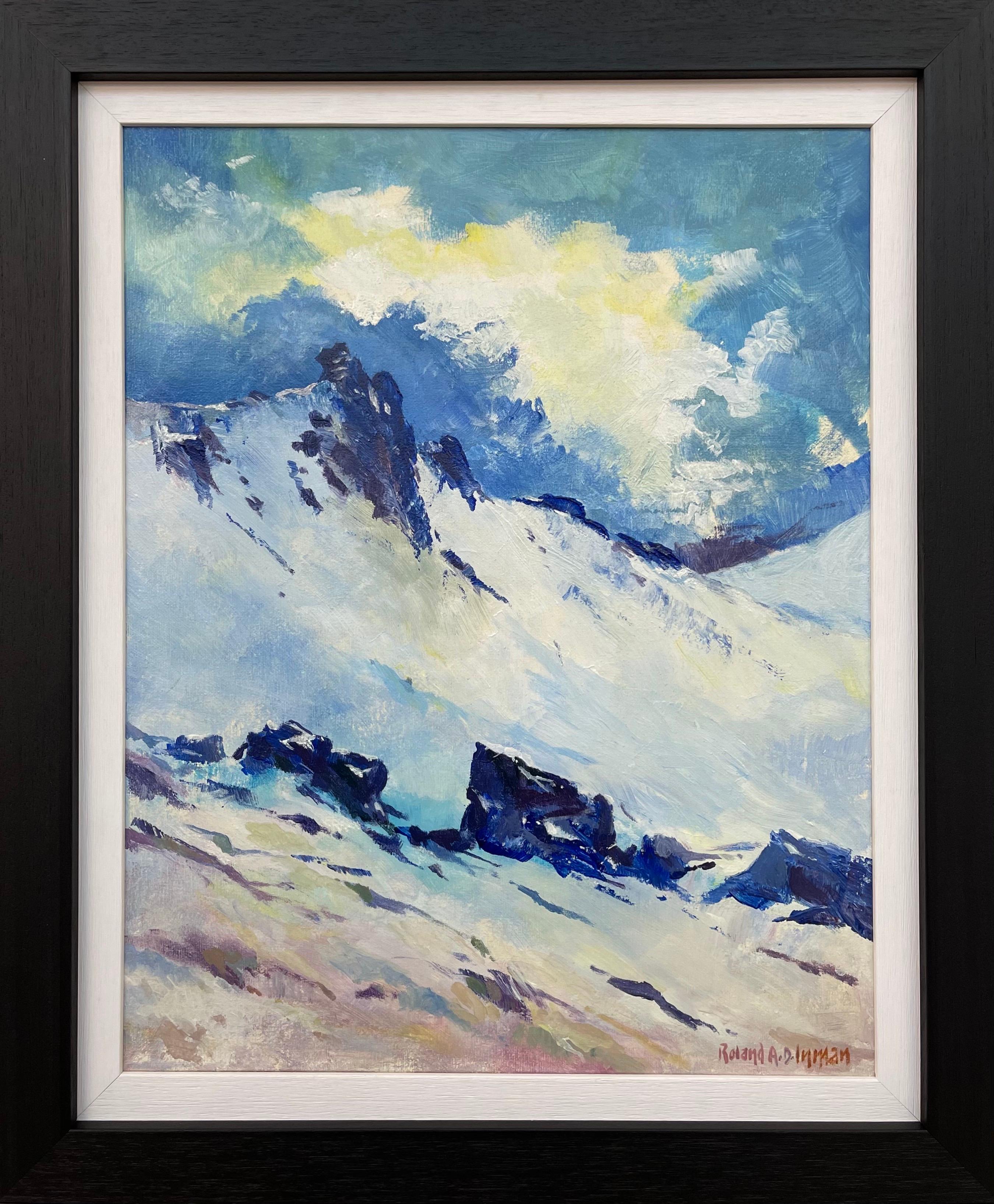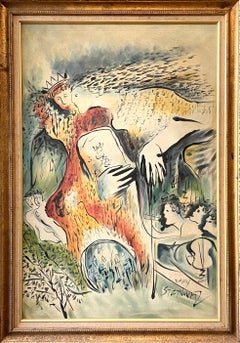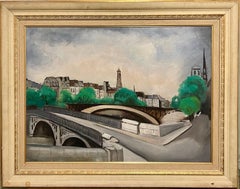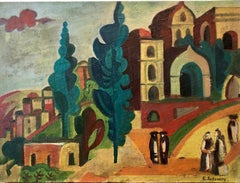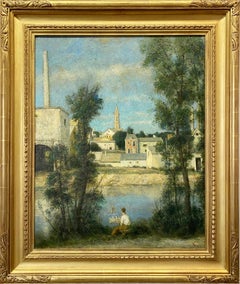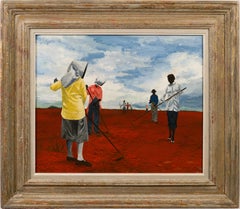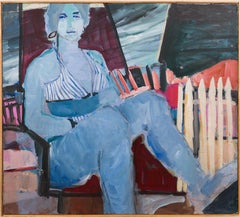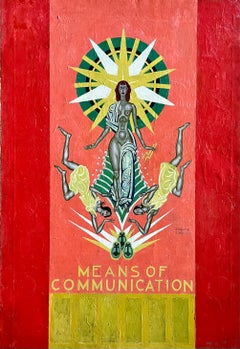Items Similar to Austrian Magic Realist Oil Painting Vibrant Village Landscape Scene Franz Coufal
Want more images or videos?
Request additional images or videos from the seller
1 of 16
Franz Anton CoufalAustrian Magic Realist Oil Painting Vibrant Village Landscape Scene Franz Coufal
About the Item
Framed 24.5 x 28.5 image 19.5 x 23 inches.
Franz Anton Coufal (Austrian, 1927 - 1999) Painter and sculptor known for figure painting, bronze sculpture, genre paintings and as a graphic artist.
After completing an apprenticeship as a locksmith, Franz Anton Coufal attended the Graphic Education and Research Institute in Vienna from 1947 to 1949 as a student of André Roder and from 1949 to 1953 took lessons from Ignaz Schönbrunner. From 1953 to 1959 he finally studied with Fritz Wotruba at the Academy of Fine Arts (diploma and master school award 1959).
Coufal then went on study trips to Germany and Italy and then settled in Vienna as a sculptor and graphic artist. His work bears the influence of Austrian Magic Realism and the artists Friedensreich Hundertwasser, Arik Erich Brauer and Ernst Fuchs. THis work also has Expressionist elements to it. He organized exhibitions in Vienna (from 1955), Paris (1962, 1970) and Brussels (1964) as well as in other Austrian cities. His most important works include the honorary grave for Leopold Figl in the central cemetery (1966). In 1979 he provided the design for the face of the silver 100 schilling coin "Festival and Congress House Bregenz", in 1980 he created the Lehár monument for the city park, and in 1987 he received the special prize in the "Danube Region Vienna" competition.
A select list of his sculptures in public spaces
"Standing youth" (19, Hameaustraße - Celtesgasse, urban residential complex; 1960)
"Reclining youth" (22, Kagran [Meißnergasse - Maißauer Gasse - Anton-Sattler-Gasse]; artificial stone, 1962)
"Flammender Turm" (16, Thaliastraße 159; marble)
Cubist marble sculpture (11, Molitorgasse at 15)
Drinking fountain (20, Adalbert-Stifter-Straße primary school; 1968)
Figldenkmal (1, Minoritenplatz, 1973)
Coufal created some of his later works for the "Harmonie" rest home for the blind in Unterdambach near Neulengbach (memorial for the 144 blind people who perished in concentration camps, unveiled in 2000; stone sculpture "Monument to Humanity" on the terrace; rose-thorn cross and tabernacle for the in-house Odilien- Chapel; bronze portrait sculpture by Robert Vogel in the entrance hall, unveiled July 3, 1994).
Bibliography
Rudolf Schmidt: Austrian artist lexicon. From the beginning to the present. Vienna: Tusch 1974-1980
Who's Who in the world. Volume 2: 1974-1975. New Providence, NJ: Marquis Who's Who 1974
Who's who in the world. Volume 3: 1976-1977. New Providence, NJ: Marquis Who's Who 1976
Who is Who in Austria with South Tyrol part (Hübner's "Blue Who is Who"). Zug: Who is who, Verlag für Personalenzyklopädien 12 1995
Otto Breicha: Franz Anton Coufal In: Franz Anton Coufal. Österreichische Staatsdruckerei, December 9-22, 1964. Vienna: Staatsdruckerei 1964
The press, July 30, 1963
Of the generation of Viennese artists Alois Mosbacher, Josef Mikl, Oswald Oberhuber, Christian Ludwig Attersee, Peter Sengl, Max Weiler, Franz Ringel, Gunter Brus, Hubert Schmalix, Wilhelm Kaufmann, Paul Flora, Oscar Larsen, Hans Staudacher, Siegfried Anzinger, Ernst Huber, Karl Korab, Josef Dobrowsky, Ludwig Heinrich Jungnickel, Oskar Laske
- Creator:Franz Anton Coufal (1927 - 1999)
- Dimensions:Height: 24.5 in (62.23 cm)Width: 28.5 in (72.39 cm)
- Medium:
- Movement & Style:
- Period:
- Condition:good. frame has minor wear.
- Gallery Location:Surfside, FL
- Reference Number:1stDibs: LU3829401352
About the Seller
4.9
Platinum Seller
Premium sellers with a 4.7+ rating and 24-hour response times
Established in 1995
1stDibs seller since 2014
1,744 sales on 1stDibs
Typical response time: 2 hours
- ShippingRetrieving quote...Shipping from: Surfside, FL
- Return Policy
Authenticity Guarantee
In the unlikely event there’s an issue with an item’s authenticity, contact us within 1 year for a full refund. DetailsMoney-Back Guarantee
If your item is not as described, is damaged in transit, or does not arrive, contact us within 7 days for a full refund. Details24-Hour Cancellation
You have a 24-hour grace period in which to reconsider your purchase, with no questions asked.Vetted Professional Sellers
Our world-class sellers must adhere to strict standards for service and quality, maintaining the integrity of our listings.Price-Match Guarantee
If you find that a seller listed the same item for a lower price elsewhere, we’ll match it.Trusted Global Delivery
Our best-in-class carrier network provides specialized shipping options worldwide, including custom delivery.More From This Seller
View AllKing David, Jerusalem (after Marc Chagall) Oil Painting Israeli Judaica Art
By Zammy Steynovitz
Located in Surfside, FL
Framed 41.5 x 29.5 image 35.5 x 23.5
This large painting depicts a man and woman, Adam and Eve, interlocked and embracing one another. The woman holds an enticing apple as they are thrusted from the Garden of Eden.
This is an original painting. Zamy Steynovitz was born in Liegnitz Poland, in 1951. He immigrated to Israel in 1957. The aspiration to be a painter stems from his childhood and before leaving Poland, he won the first prize in an art competition for children.
Zamy was formally educated at the Art School in Tel-Aviv and at the Royal Academy of London. Upon completing his studies, Zamy earnestly pursued his career and establish his place in the art world by displaying his work in one man exhibits and arts fairs around the world.
His art displays chromatic and thematic richness and his choice of subjects has been strongly influenced by Jewish tradition, his Eastern European Jewish heritage and folklore. Zamy’s popular themes include Paris cafes, still-life, flowers, circuses and landscapes. Circus with acrobats and Harlequin. In the early stages of his career, he was partial to rich pastels and light brush strokes.
In the early 1980s, Zamy visited South America, where the new surroundings enhanced his work with local brightness and color. His art gained chromatic power and his palette became richer in tones as the textures became thicker and the background darker and more colorful. These changes coupled with his thematic persistence allowed him to develop into a sensitive and mature artist.
Zamy expresses a universal humanistic vision in his creations: man’s connection to his heritage and physical surroundings, two imperative aspects of our lives that should be heralded during these estranged technological times.
As a result of his devotion to world peace, Zamy is known in the circles of the Nobel Institute for Peace in Norway. He is acquainted with many Nobel Prize winners including Anwar Sadat, Menachem Begin, the Dalai Lama, Itzhak Rabin, Shimon Peres, Elie Wiesel, Desmond Tutu and Oscar Arias, the ex-President of Costa Rica, along with many other politicians and artists. Zamy tragically passed away in September 2000.
Exhibitions One Man Show
1970 - Museum - Ramat - Gan
1973 - Brussels - Gallery L'Angle Aigu
1974 - London - International Gallery
1974 - Paris - Grand Palais Gallery
1975 - Milan - Brera Gallery
1976 - N.Y. Valentino Gallery - N.Y. Hilton
1977 - N.Y. Valentino Gallery - N.Y. Hilton
1978 - Basel - Actual Gallery
1978 - Geneve - Bohren Gallery
1978 - Oslo - Nobel Peace Prize Exhibit
1979 - London - Hamilton Gallery
1979 - N.Y. - Art Israel Kalt - Waldinger Gallery
1979 - N.Y. - Canty Art Gallery
1979 - Amsterdam - Schipper Gallery
1979 - Washington - International Art Fair
1980 - Cleveland -Jewish Museum
1980 - Tel-Aviv - Habima National Art Fair
1981 - Abraham - Goodman House N.Y.
1981 - San Lucas Galley - Bogota
1982 - Pedro Gerson Gallery - Mexico City
1983 - Simon Bolivar...
Category
20th Century Modern Figurative Paintings
Materials
Oil, Canvas
1927 Oil Painting Eiffel Tower Paris American Modernist Wpa Artist Morris Kantor
By Morris Kantor
Located in Surfside, FL
Morris Kantor New York (1896 - 1974)
Paris from the Ile St. Louis, 1927 (view of Eiffel Tower)
Oil painting on canvas
Hand Signed lower left.
Provenance: Hirshhorn Museum and Sculpture Garden, Smithsonian Institution ( bears label verso)
Size: 20 3/4"H x 28 1/8"W (sight), 28.75 "H x 36"W (framed)
Morris Kantor (Belarusian: Морыс Кантор) (1896-1974) was a Russian Empire-born American painter based in the New York City area.
Born in Minsk on April 15, 1896, Kantor was brought to the United States in 1906 at age 10, in order to join his father who had previously relocated to the states. He made his home in West Nyack, New York for much of his life, and died there in 1974. He produced a prolific and diverse body of work, much of it in the form of paintings, which is distinguished by its stylistic variety over his long career. Perhaps his most widely recognized work is the iconic painting "Baseball At Night", which depicts an early night baseball game played under artificial electric light. Although he is best known for his paintings executed in a realistic manner, over the course of his life he also spent time working in styles such as Cubism and Futurism, and produced a number of abstract or non-figural works. A famous cubist, Futurist, painting of his "Orchestra" brought over 500,000$ at Christie's auction house in 2018
Kantor found employment in the Garment District upon his arrival in New York City, and was not able to begin formal art studies until 1916, when he began courses at the now-defunct Independent School of Art. He studied landscape painting with Homer Boss (1882-1956). In 1928, after returning to New York City from a year in Paris, Kantor developed a style in which he combined Realism with Fantasy, often taking the streets of New York as his subject matter. He did some moody Surrealist Nude paintings and fantasy scenes. In the 1940's he turned towards figural studies. Later in his career, Kantor himself was an instructor at the Cooper Union and also at the Art Students League of New York in the 1940s, and taught many pupils who later became famous artists in their own right, such as Knox Martin, Robert Rauschenberg, Sigmund Abeles and Susan Weil...
Category
1920s American Modern Landscape Paintings
Materials
Canvas, Oil
1930 Oil Painting Sea Side Sailboats American Modernist WPA Artist Morris Kantor
By Morris Kantor
Located in Surfside, FL
Morris Kantor, American, 1896-1974
Seaside View, 1930
Hand signed M. Kantor and dated 1930 lower right
Oil on canvas
22 1/4 x 19 1/4 inches
24 1/2 x 21 (frame)
Morris Kantor (Belarusian: Морыс Кантор) (1896-1974) was a Russian Empire-born American painter based in the New York City area. This is a beautiful boat scene with a river or lake probably on Long Island.
Born in Minsk on April 15, 1896, Kantor was brought to the United States in 1906 at age 10, in order to join his father who had previously relocated to the states. He made his home in West Nyack, New York for much of his life, and died there in 1974. He produced a prolific and diverse body of work, much of it in the form of paintings, which is distinguished by its stylistic variety over his long career. Perhaps his most widely recognized work is the iconic painting "Baseball At Night", which depicts an early night baseball game played under artificial electric light. Although he is best known for his paintings executed in a realistic manner, over the course of his life he also spent time working in styles such as Cubism and Futurism, (influenced by the Art Deco movement) and produced a number of abstract or non-figural works. A famous cubist, Futurist, painting of his "Orchestra" brought over 500,000$ at Christie's auction house in 2018. Kantor found employment in the Garment District upon his arrival in New York City, and was not able to begin formal art studies until 1916, when he began courses at the now-defunct Independent School of Art. He studied landscape painting with Homer Boss (1882-1956). In 1928, after returning to New York City from a year in Paris, Kantor developed a style in which he combined Realism with Fantasy, often taking the streets of New York as his subject matter. He did some moody Surrealist Nude paintings and fantasy scenes. In the 1940's he turned towards figural studies. Later in his career, Kantor himself was an instructor at the Cooper Union and also at the Art Students League of New York in the 1940s, and taught many pupils who later became famous artists in their own right, such as Knox Martin, Robert Rauschenberg, Sigmund Abeles and Susan Weil...
Category
1930s American Modern Landscape Paintings
Materials
Canvas, Oil
Outside the Synagogue Russian Judaica Oil Painting
By Emmanuel Snitkovsky
Located in Surfside, FL
This piece came from the collection of the Bezalel Art Gallery on the Lower East Side of New York City.
Emmanuil Snitkovsky is an internationally known artist, sculpture and poet.
Emmanuil Snitkovsky was born into a family of artists and scholars from the Odessa Art College in Russia. Immersed in the traditions of Russia art, he approaches form, line, space and color with relentless vision and impeccable technique.
Two highly successful artists, the husband and wife team of Emmanuil and Janet Snitkovsky have exhibited a selection of eight large Judaic paintings at the Chabad Chassidic Art Institute (Chai Gallery) in Crown Heights. Three of those paintings are truly singular visions of Jewish Art that cause us to stop and reassess our preconceptions about the meaning and importance of their subjects. Emmanuil and Janet Snitkovsky were both born in the Ukraine in the 1930′s. Emmanuil was trained in Odessa in public monument art, and Janet majored in fashion at the Lvov Decorative Art Institute. After both narrowly survived the devastation of the Second World War in Stalin’s Russia, they began to collaborate on state sponsored art works in 1962. For ten years, they worked on grandiose public sculptural projects to commemorate the fallen Russian heroes of the Second World War in Moscow, Kiev, Tula and Kazan. They were
exemplary Soviet Realists working for the Soviet regime. Eventually, this career became untenable for them, both as artists and as Jews, when they clashed with Soviet officialdom over a commission to commemorate the Babi-Yar massacre. The Soviets refused to acknowledge this massacre of 100,000 Jews and eventually suppressed the memorial. In 1978, Emmanuil and Janet arrived in New York and began to recreate their artistic lives. In the ensuing 25 years, they have been quite successful, exhibiting widely in the United States and Europe. They have nurtured a hybrid style of painting and sculpture called “Renaissance Revival” combining contemporary and classical subjects in a stylized realism that evokes both the American regionalist Thomas Hart
Benton and the Italian Renaissance master Sandro Botticelli. The works are highly proficient, polished, and commercial productions in a quirky decorative style. They have continued to accept sculptural projects that have not shied away from kitschy realistic sculptures of Charlie Chaplin as “The Kid,” The Little Tramp” and Buster Keaton as “Cameramen.” In some ways, they have appropriated American culture just as they once accepted Soviet culture.
Janet, a graduate of the Lvov College, was invited- by virtue of the high honors she
achieved there- to matriculate at the Lvov University of Art. Such an opportunity is extremely rare for anyone, particularly for someone of Jewish descent. Their works of art are included in collections of the Japanese Imperial Family...
Category
1980s Modern Landscape Paintings
Materials
Canvas, Oil, Illustration Board
Rare Israeli Naive Art Oil Painting Jerusalem Israel Old City Landscape Folk Art
Located in Surfside, FL
JERUSALEM, Vielle du David, (City of David)
Oil painting on canvas
Hand signed in Hebrew (Perlman, Pearlman or Perelman. There are numerous artists with this name. we are unsure wh...
Category
20th Century Folk Art Landscape Paintings
Materials
Canvas, Oil
Arie Azene Israeli Photo Realist Oil Painting Manhattan New York Street Scene
By Arie Azene
Located in Surfside, FL
Arie Azene, Israeli painter, born in Germany, 1934
Arie (Eisman) Azene was born in Hamburg, Germany. He immigrated to the Land of Israel with his parents soon after birth. In 1958, after studying art in Paris, he settled on Kibbutz Tzova in the Judean Hills, where he lived for 28 years. He spent 1968-1970 in France, England and Germany. In 1984, he moved to Jerusalem.
Stylistically, Azene was influenced by the New Horizons group to which he was exposed during his studies at the Avni Institute in Tel Aviv. Other influences were Joseph Zaritsky, Avigdor Stematsky and Yehezkel Streichman.
Azene works in oil paint, pencil and aquarelle. His early work was abstract, but over the years, it has become more figurative and realistic. His colour palette is often based on two complementary hues, with a predominance of various combinations of gray.
Education
1948-51 Avni Institute, Tel Aviv
1951-52 Bezalel Academy of Arts and Design, Jerusalem
1957-58 Academie de la Grande Chaumiere, Paris, France, Advanced Studies
Select Exhibitions
Autumn Exhibition Autumn Exhibition Yad Lebanim Museum, Petach Tikva 1974
Artists: Shimon Avni, Mordechai Avniel, Azene, Arie, Eli Ilan, Michael Argov, Naftali Bezem, Nachum Gutman, Shraga Weil, Boaz Vaadia, Shmuel Katz, Ruth Schloss.
Zaritsky Artists House, Tel Aviv 1976
Artists: Yitzhak Danziger, Menashe Kadishman, Osvaldo Romberg, Michal Wolman, Raffi Lavie
The Kadishman Connection Israel Museum, Jerusalem 1979
Artists: Larry Abramson, Jacob El Hanani, Ovadia Alkara, Yosl Bergner, Marcel Janco, Lea Nikel, George Chemeche, Igael Tumarkin.
Israeli Prints...
Category
1990s Photorealist Landscape Paintings
Materials
Canvas, Oil
You May Also Like
American Pastoral
By John Koch
Located in Greenwich, CT
John Koch is a beloved American realist painter who depicted people in their everyday lives. Here we see a slightly different approach where he has put a painter out in a rural town...
Category
1940s American Modern Landscape Paintings
Materials
Canvas, Oil
Vintage Signed Surreal Black Farming Figures Modernist Landscape Oil Painting
Located in Buffalo, NY
Antique American modernist surreal landscape oil painting. Oil on canvas. Framed. Signed.
Category
1950s Modern Landscape Paintings
Materials
Canvas, Oil
$3,580 Sale Price
20% Off
Large American Modernist Post Impressionist Framed Portrait Oil Painting
Located in Buffalo, NY
Vintage American modernist oil painting. Oil on canvas. Framed. No signature found.
Category
1950s Modern Landscape Paintings
Materials
Canvas, Oil
$1,036 Sale Price
20% Off
NYC 1939 World's Fair Mural Study American Scene WPA Modern Mid 20th Century
Located in New York, NY
NYC 1939 World's Fair Mural Study American Scene WPA Modern Mid 20th Century
Eugene Savage (1883 – 1978)
1939 World’s Fair Mural Study
45 x 30 inches
Oil on Canvas
Signed lower right
The painting is part of a 1,000 piece collection of art and objects from the 1939 World’s Fair. The collection as a whole is available.
Savage created the mural for the facade of the Communications Building. An image of the completed mural, along with a published postcard, is part of the listing. Note the center top female figure, she resembles the figure in the offered painting.
BIO
Eugene Francis Savage was born in Covington, Indiana 1883. He underwent various forms of art training in the early years. He was a pupil of The Corcoran Gallery and The Art Institute of Chicago, and was later awarded a fellowship to study in Rome at The American Academy.
While under the spell of that ancient city the young artist began to render historic figures that were suitable for the classic style needed for mural painting in the traditional manor. During this period he was able to study and observe Roman and Greek sculpture, although much of the academic training was accomplished by using plaster casts along with the incorporation of live models. This method survived and was used efficiently throughout Europe and the United States.
After leaving the Academy, Savage was commissioned to paint numerous murals throughout the United States and Europe. This artist received acclaim for the works he produced while under commissions from various sources. This young master was a contemporary of Mexican muralists David Alfaro Siqueiros (1896-1974), Jose Clemente Orozco (1883-1949) and Diego Rivera (1886-1957). In this period he was to show the influence of his contemporaries in formulating a modern style. Savage also played a vital role in the WPA Federal Art program, and he was a member of The Mural Art Guild..
Savage was elected an associate member of The National Academy of Design in 1924 and a full member in 1926. From 1947, he held a professorship at Yale University where he taught mural painting, and some of his students went on to significant positions.
By this time the artist had painted large-scale murals at Columbia, Yale University, Buffalo N.Y., Dallas, Texas, Chicago, Indiana, along with other commissioned works. He also achieved recognition for a series of murals commissioned by the Matson Shipping Line and completed around 1940. For this commission, Savage made many exacting studies of customs and folkways of the Hawaiian natives. However, the award-winning murals were not installed as planned but were put in storage during the war years when the ships were used for troop transportation and were in danger of attack.
However the mural images were reproduced and distributed by the shipping company including nine of the mural scenes that were made into lithographed menu covers in 1948. The American Institute of Graphic Arts awarded certificates of excellence for their graphic production, and the Smithsonian Institute exhibited the works in 1949. Today Savages' Hawaiian Art production is held in high regard by collectors of Hawaiian nostalgia.
In later years the artist focused his attention on a theme that dealt with the customs and tribal traditions of the Seminole Indians of Florida. He produced many variations of this theme throughout his lifetime, and the pictures were usually modest scale easel paintings, precise and carefully delineated. Many of these pictures incorporate Surrealistic elements and show some minor stylistic influences of the painters Kay Sage...
Category
1930s American Modern Figurative Paintings
Materials
Canvas, Oil
Antique American Impressionist Ashcan School Junk Collector Cityscape Painting
Located in Buffalo, NY
Antique American modernist cityscape painting titled "The Junk Collector" by Clarence E. Van Duzer (1920 - 2009). Oil on board, circa 193...
Category
1920s Modern Landscape Paintings
Materials
Canvas, Oil
$2,796 Sale Price
20% Off
Blue & White Oil Painting of the Mourne Mountains Ireland by Modern Irish Artist
Located in Preston, GB
Blue & White Oil Painting of the Mourne Mountains Ireland by Modern Irish Artist
Art measures 16 x 20 inches
Frame measures 21 x 25 inches
Category
Late 20th Century Modern Landscape Paintings
Materials
Oil, Canvas
